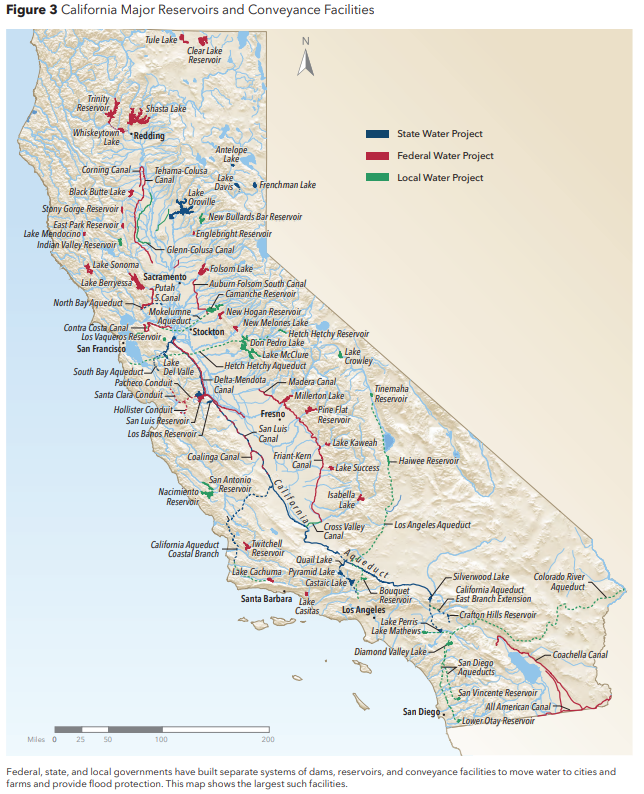Three California state agencies today released a draft water resilience portfolio intended to help the state manage more extreme droughts and floods, aging infrastructure, declining fish populations and other challenges.
The California Natural Resources Agency, California Environmental Protection Agency and Department of Food and Agriculture developed the draft to fulfill Governor Gavin Newsom’s April 29, 2019 executive order calling for a portfolio of actions to ensure the state’s long-term water resilience and ecosystem health.
“The portfolio approach to water supply reliability is a significant advance in how our most precious resource is managed statewide, in line with our long-term strategy in San Diego County,” said Sandra L. Kerl, general manager of the San Diego County Water Authority. “As we review the details of the new plan, we will continue collaborating with the state agencies and other partners to turn this vision into a reality that benefits our region.”

State and Water Authority officials before aerial and ground tour of regional water infrastructure on July 18, 2019. Photo: Water Authority
State agency leaders tour water infrastructure in San Diego County
Several state officials visited San Diego County on July 18, 2019 to assess the region’s water projects as part of their role in developing a water portfolio strategy for the state.
Natural Resources Secretary Wade Crowfoot, Deputy Natural Resources Secretary Thomas Gibson, State Department of Food and Agriculture Secretary Karen Ross, and State Water Resources Board Chair E. Joaquin Esquivel got a first-hand look at investments to diversify the region’s water supply, including the San Vicente Reservoir, Olivenhain Reservoir, and the Claude “Bud” Lewis Carlsbad Desalination Plant.
“San Diego is a great example of the challenges and complexities of managing water supply, as we look to supercharge water resiliency in California,” said E. Joaquin Esquivel, Chair, Calif. State Water Resources Control Board, after the July tour of water infrastructure.
Newsom’s order directed his administration to “identify and assess a suite of complementary actions to ensure safe and resilient water supplies, flood protection and healthy waterways for the state’s communities, economy and environment.”
Draft Water Resilience Portfolio encourages ‘collaboration within and across regions’
“This draft portfolio has been shaped to provide tools to local and regional entities to continue building resilience and to encourage collaboration within and across regions,” said Natural Resources Secretary Wade Crowfoot in a news release from the three agencies. “At the same time, state government needs to invest in projects of statewide scale and importance and tackle challenges beyond the scope of any region. Taken together, the proposed actions aim to improve our capacity to prepare for disruptions, withstand and recover from shocks, and adapt from these experiences.”
The draft release comes after several months of public input, and listening sessions, including comments from the San Diego County Water Authority and its 24 member agencies.
Draft Water Resilience Portfolio outlines more than 100 integrated actionable recommendations in four broad areas:
-
Maintain and diversify water supplies
State government will continue to help regions reduce reliance on any one water source and diversify supplies to enable flexibility amidst changing conditions. Diversification will look different in each region based on available water resources, but the combined effect will strengthen resilience and reduce pressure on river systems.
-
Protect and enhance natural ecosystems
State leadership is essential to restore the environmental health of key river systems to sustain fish and wildlife. This requires effective standard-setting, continued investments, and more adaptive, holistic environmental management.
-
Build connections
State actions and investment will improve physical infrastructure to store, move, and share water more flexibly and integrate water management through shared use of science, data, and technology.
-
Be prepared
Each region must prepare for new threats, including more extreme droughts and floods and hotter temperatures. State investments and guidance will enable preparation, protective actions, and adaptive management to weather these stresses.

Federal, state, and local governments have built separate systems of dams, reservoirs, and conveyance facilities to move water to cities and farms and provide flood protection. This map, from the draft Water Resilience Portfolio, shows the largest such facilities. Graphic: State of California
To develop the portfolio, state agencies conducted an inventory and assessment of key aspects of California water, soliciting broad input from tribes, agencies, individuals, groups, and leaders across the state.
“From Northern California to the Central Valley and the South, Californians from cities, farms, and other sectors are working together to develop innovative solutions to the climate-related water challenges that the state is already experiencing and that are expected to worsen,” said California Environmental Protection Agency Secretary Jared Blumenfeld. “This draft portfolio is an important step toward building resilience to ensure the long-term health of our water supplies and ecosystems.”
Public comments on draft portfolio
The public will be able to submit written feedback on the draft portfolio through February 7. A final water resilience portfolio will be released soon after that.
“State agencies are only one set of water decision-makers in California,” California Secretary for Food and Agriculture Karen Ross said. “Continuing to improve our water systems relies on collaboration across all groups of water users and all stakeholders. Accordingly, feedback on this draft will be important to refining and finalizing our portfolio.”






